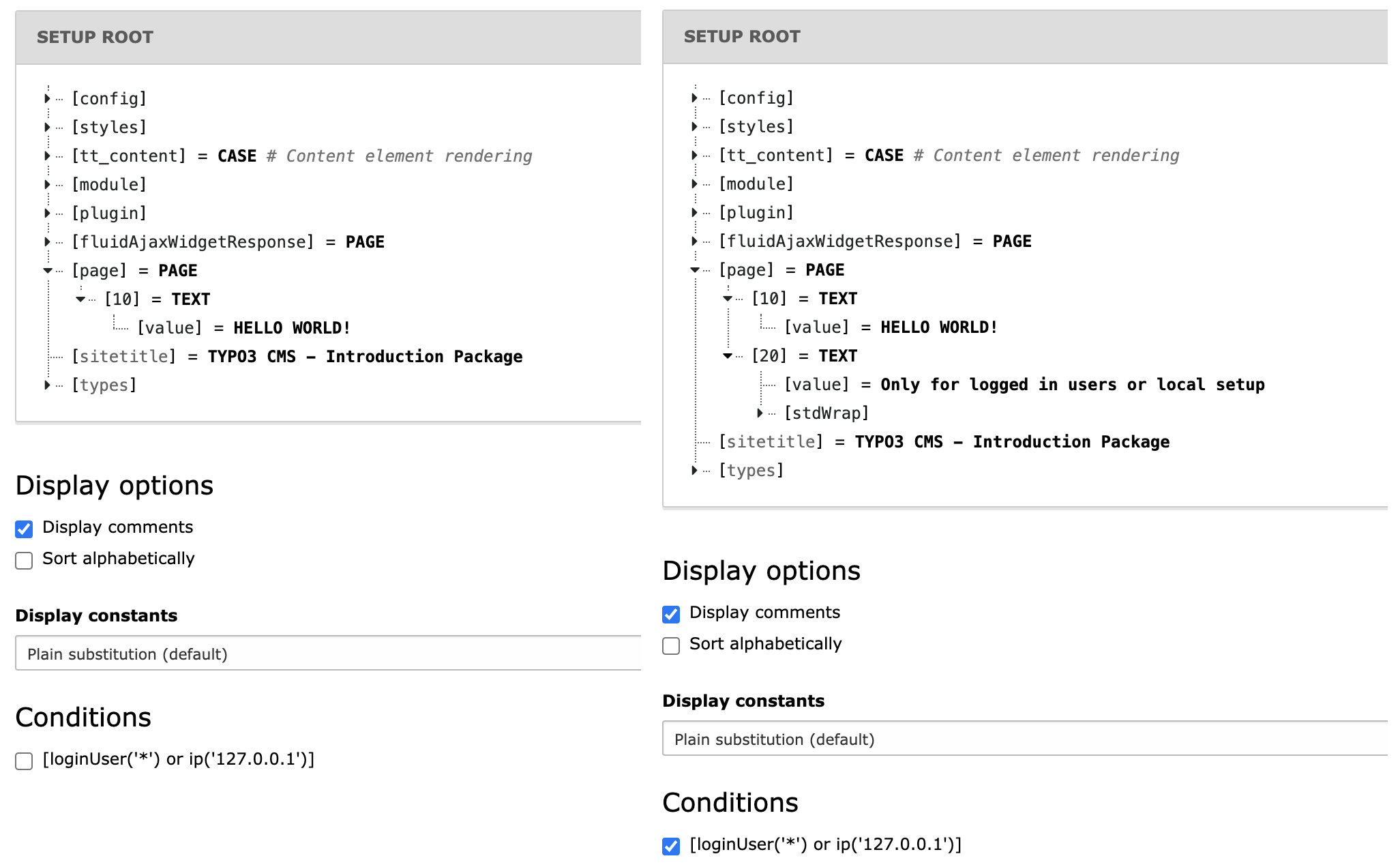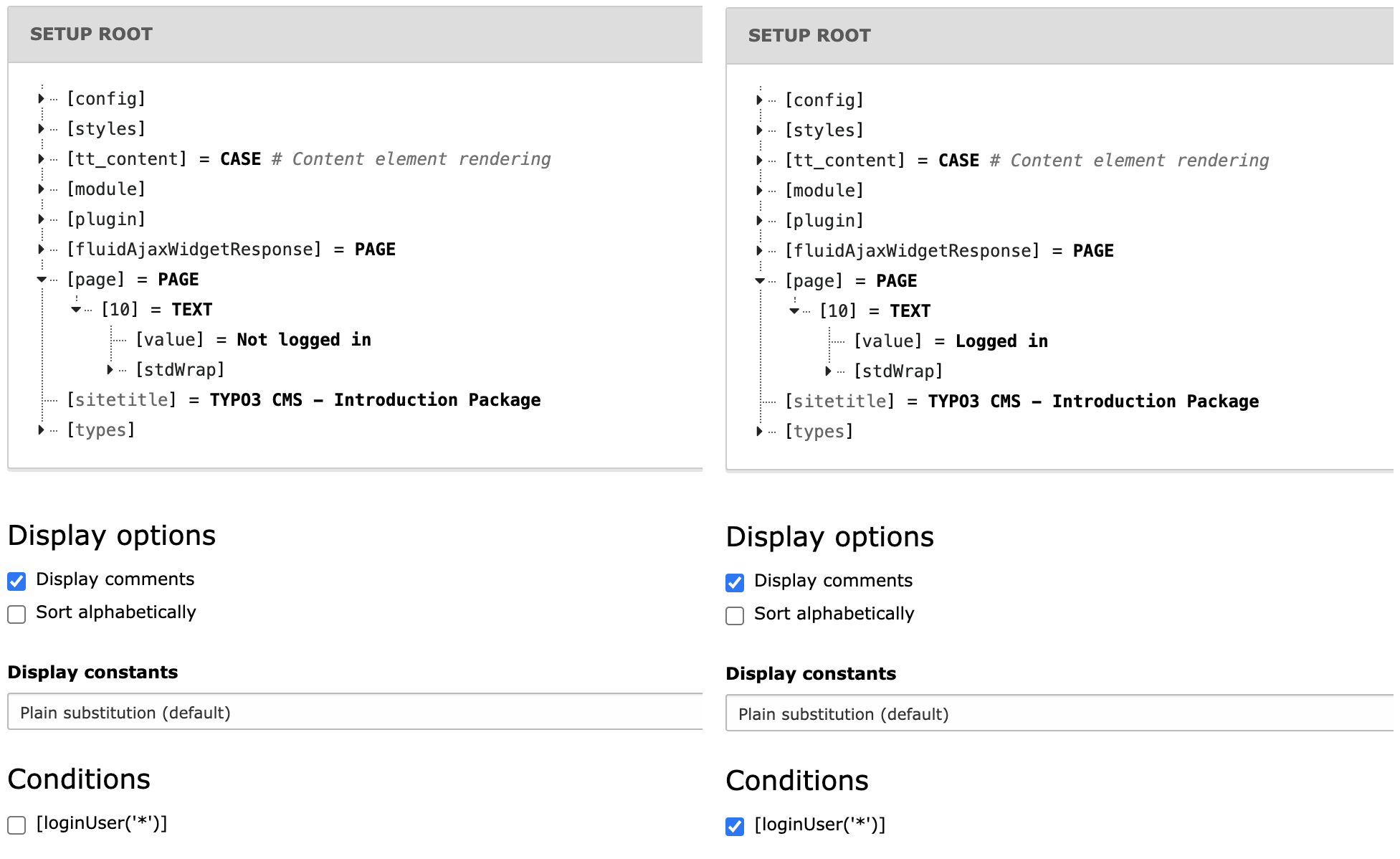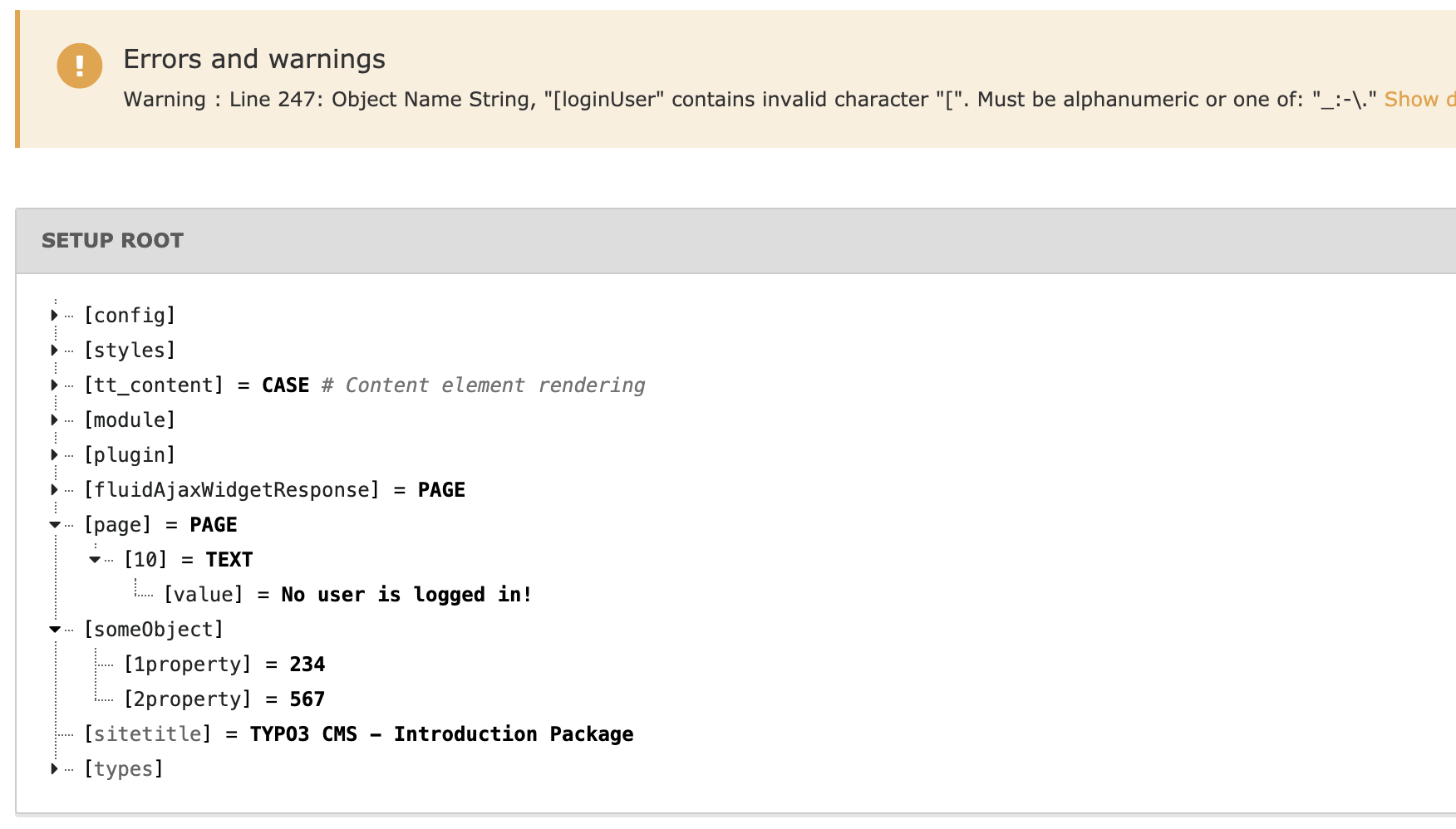Attention
TYPO3 v10 has reached end-of-life as of April 30th 2023 and is no longer being maintained. Use the version switcher on the top left of this page to select documentation for a supported version of TYPO3.
Need more time before upgrading? You can purchase Extended Long Term Support (ELTS) for TYPO3 v10 here: TYPO3 ELTS.
Conditions¶
There is a possibility of using so called conditions in TypoScript. Conditions are simple control structures, that evaluate to TRUE or FALSE based on some criteria (externally validated) and thereby determine, whether the TypoScript code following the condition and ending where the next condition is found, should be parsed or not.
Note
The condition syntax was changed with TYPO3v9, support for the old syntax was removed in TYPO3v10. See Migration from the legacy condition syntax
Examples of a condition could be:
Is a usergroup set for the current session?
Is it Monday?
Is the GET parameter "&language=uk" set?
Is it my mother's birthday?
Do I feel lucky today?
Of these examples admittedly the first few are the most realistic. In fact they are readily available in the context of TypoScript Templates. But a condition can theoretically evaluate any circumstance and return either TRUE or FALSE which subsequently means the parsing of the TypoScript code that follows.
See also
For conditions usage examples, and available variables and function reference, please refer to the TypoScript Reference conditions chapter.
Where conditions can be used¶
The detection of conditions is a part of the TypoScript syntax but the validation of the condition content always relies on the context where TypoScript is used. Therefore in plain syntax highlighting (no context) conditions are just highlighted and nothing more. In the context of TypoScript Templates there is a whole section of TSref which defines the syntax of the condition contents for TypoScript Templates. For "Page TSconfig" and "User TSconfig" conditions are implemented as well. Basically they work the same way as conditions in TypoScript templates do, but there are some small differences. For details see the chapter on conditions in TSconfig.
The syntax of conditions¶
A condition is written on its own line and is detected by [
(square bracket) being the first character on that line:
# ... some TypoScript
[ condition ]
# .... some more TypoScript (only parsed if the condition is met.)
[GLOBAL]
(Some TypoScript)
As you can see from this example, the line [GLOBAL] also is a
condition. It is built into TypoScript and always returns TRUE. The
line [ condition ] is another condition.
If [ condition ] is TRUE, then the TypoScript in the
middle would be parsed until [GLOBAL] (or [END]) resets the
condition. After that point the TypoScript is parsed for any case
again.
Here is an example of some TypoScript (from the context of TypoScript Templates) where another text is output if you are logged in or working locally:
page = PAGE
page.10 = TEXT
page.10.value = HELLO WORLD!
[loginUser('*') or ip('127.0.0.1')]
page.20 = TEXT
page.20 {
value = Only for logged in users or local setup
stdWrap.case = upper
}
[GLOBAL]
You can now use the Object Browser to actually see the difference in the parsed object tree depending on whether the condition evaluates to TRUE or FALSE (which can be simulated with that module as you can see):

Combining conditions¶
As we saw above two or more tests can be combined using logical operators. The following operators are available:
- or
Also available as
||.- and
Also available as
&&.- not
Also available as
!.
TypoScript conditions are using the Symfony Expression Language. For more information on writing such expressions, you can look up the symfony documentation on the expression language.
Note
Before TYPO3 10, it was possible to "chain" multiple condition blocks
together with AND, OR, && and || by writing
something like [ condition 1 ][ condition 2 ] or
[ condition 1 ] AND [ condition 2 ]. This is no longer possible or
necessary, as with the new Symfony Expression Language,
only single condition blocks on one line are now allowed. Logical operators
like and, or or not are now used inside the
condition block to allow for writing complex expressions.
The Special [ELSE], [END] and [GLOBAL] Conditions¶
The special condition [ELSE] which will return TRUE if
the previous condition returned FALSE. To end an [ELSE] condition you
can use either [END] or [GLOBAL]. For all three conditions you can
also use them in lower case.
Here's an example of using the [ELSE] condition (also in the context
of TypoScript Templates):
page = PAGE
page.10 = TEXT
[loginUser('*')]
page.10.value = Logged in
[ELSE]
page.10.value = Not logged in
[END]
page.10.stdWrap.wrap = <strong>|</strong>
Here we have one output text if a user is logged in and
another if not. No matter what the text is wrapped in a <strong> tag,
because, as we can see, this wrap is added outside of the condition block
(e.g. after the [END] condition).

The fact that you can "enable" the condition in the TypoScript Object Browser is a facility provided to simulate the outcome of any conditions you insert in a TypoScript Template. Whether or not the conditions validate correctly is only verified by actually getting (in this example) a logged in user and hitting the site.
Another example could be if you wanted to do something special in case a bunch of conditions is NOT true. There's no negate-character, but you could do this:
[!loginUser('*')]
page.10.value = No user is logged in!
[END]
Where to insert conditions in TypoScript?¶
Conditions can be used outside of confinements (curly braces) only!
So, this is valid:
someObject {
1property = 234
}
[loginUser('*')]
someObject {
2property = 567
}
But this is not valid:
someObject {
1property = 234
[loginUser('*')]
2property = 567
}
When parsed with syntax highlighting you will see this error:

This means that the line was perceived as a regular definition of TypoScript and not as a condition.
The [GLOBAL] condition¶
The [GLOBAL] special condition (which resets any previous
condition scope) is yet different, in that will be detected at
any line except within multiline value definitions.
someObject {
1property = 234
[GLOBAL]
2property = 567
}
But you will still get some errors if you syntax highlight it:

The reason for this is that the [GLOBAL] condition aborts the
confinement started in the first line resulting in the first error
("... short of 1 end brace(s)"). The second error appears because the
end brace is now in excess since the "brace level" was reset by
[GLOBAL].
So, in summary; the special [global] (or [GLOBAL]) condition will
break TypoScript parsing within braces at any time and return to the
global scope (unless entered in a multiline value). This is true for
any TypoScript implementation whether other condition types are
possible or not. Therefore you can use [GLOBAL] (put on a single line
for itself) to make sure that following TypoScript is correctly parsed
from the top level. This is normally done when TypoScript code from
various records is combined.
Custom conditions with the Symfony expression language¶
Further information about how to extend TypoScript with your own custom conditions can be found within TypoScript conditions.
Summary¶
Conditions are detected by
[as the first line character (whitespace ignored).Conditions are evaluated in relation to the context where TypoScript is used. They are widely used in TypoScript Templates and can also be used in Page TSconfig or User TSconfig.
Special conditions
[ELSE],[END]and[GLOBAL]exist.Conditions can be used outside of confinements (curly braces) only. However the
[GLOBAL]condition will always break a confinement if entered inside of one.
Migration from the legacy condition syntax¶
Changed in version 9.4: The old condition syntax was deprecated in TYPO3v9 and removed in TYPO3v10 with the introduction of the Symfony Expression Language (SEL) in this change: Feature: #85829 - Implement symfony expression language for TypoScript conditions
For information on how to migrate from the old pre-SEL style TypoScript conditions to the new SEL-conditions please see below:
Variables and functions¶
For a detailed list of the available objects and functions refer to the TypoScript Reference.
Variables:
[page["backend_layout"] == 1]
# Old syntax: [globalVar = TSFE:page|backend_layout = 1]
page.42.value = Backend layout 1 choosen
[END]
Functions:
[loginUser('*')]
# Old syntax: [loginUser = *]
page.42.value = Frontend user logged in
[END]
[getTSFE().isBackendUserLoggedIn()]
# Old syntax [globalVar = TSFE : beUserLogin > 0]
page.42.value = Backend user logged in
[END]
Migrating literals¶
Have a look at the SEL supported literals.
Strings:
[request.getNormalizedParams().getHttpHost() == 'www.example.org']
# Old syntax: [globalString = IENV:HTTP_HOST = www.example.org]
page.42.value = Http Host is www.example.org
[END]
Arrays:
[page["pid"] in [17,24]]
# Old syntax: [globalVar = TSFE:page|pid=17, TSFE:page|pid=24]
page.42.value = This page is a child of page 17 or page 24
[END]
Migrating operators¶
Please see a complete list of availible operators here: SEL syntax operators
Equality:
[applicationContext == "Development"]
# Old syntax: [applicationContext = Development]
page.42.value = The application context is exactly "Development"
[END]
Wildcards / regular expressions:
[like(applicationContext, "Development*")]
# Old syntax: [applicationContext = Development*]
page.42.value = The application context starts with "Development"
[END]
[applicationContext matches "/^Development/"]
# Old syntax: [applicationContext = Development*]
page.42.value = The application context starts with "Development"
[END]
Array operators:
[17 in tree.rootLineIds || 24 in tree.rootLineIds]
# Old syntax: [PIDinRootline = 17, 24]
[END]
Migrating combined conditions¶
Conjunctions (AND conditions):
[condition1() and condition2()]
# Old syntax [ condition1 ][ condition2 ]
page.42.value = Condition 1 and condition 2 met
[END]
Disjunctions (OR conditions):
[condition1() or condition2()]
# used to be [ condition1 ] || [ condition2 ]
temp.value = Condition 1 or condition 2 met
[END]
Migrating user functions¶
In order to migrate user functions for example
# Old syntax [userFunc = user_match(checkLocalIP, 192.168)] provide
custom variables or
functions with the Symfony
Expression Language.
